Field Study of Photovoltaic Systems with Anti-Potential-Induced-Degradation Mechanism: UVF, EL, and Performance Ratio Investigations
Abstract
1. Introduction
2. PV System and Data Acquisition
- Plan 1: Examine the EL and UVF images for both PV strings at day 1 of operation. In addition, take the I-V and P-V curves measurement at respectively high irradiance conditions. Both EL and UVF were taken using Brightspot automation EL and UVF detection cameras. In addition, the I-V and P-V curves were measured using a PV200 Solar PV Tester; the accuracy of this device was ±0.25 V and ±0.1 A.
- Plan 2: Repeat the examination undertaken at plan one after three years of field operation.
- Plan 3: Estimate the performance ratio of the PV strings.
- Plan 4: Compare both PV strings’ thermal performance after three years to check whether any cells developed hotspots. This was accomplished by taking the thermal images using a FLIR E54 thermal camera with a thermal sensitivity of ±0.1 °C.
3. Results
3.1. Inspection of the PV Strings at Day 1
3.2. Inspecting the PV Strings after Three Years of Field Service
3.3. Performance Ratio Analysis
3.4. Thermographic Inspection
4. Conclusions
- Only 0.42% of the first string had cracks or PID, compared to 2.9% of the second string.
- In comparison to the first PV string, the output power of the second PV string dropped by 5.86%.
- First and second PV strings had average PR ratios of 91.4% and 87.8%, respectively.
- In the second PV string, 5% of the total solar cells had hotspots, as opposed to 0.42% in the first string.
Author Contributions
Funding
Institutional Review Board Statement
Informed Consent Statement
Data Availability Statement
Conflicts of Interest
References
- Hallam, B.; Herguth, A.; Hamer, P.; Nampalli, N.; Wilking, S.; Abbott, M.; Wenham, S.; Hahn, G. Eliminating Light-Induced Degradation in Commercial p-Type Czochralski Silicon Solar Cells. Appl. Sci. 2018, 8, 10. [Google Scholar] [CrossRef]
- Kopecek, R.; Libal, J. Bifacial Photovoltaics 2021: Status, Opportunities and Challenges. Energies 2021, 14, 2076. [Google Scholar] [CrossRef]
- Ascencio-Vásquez, J.; Kaaya, I.; Brecl, K.; Weiss, K.-A.; Topič, M. Global Climate Data Processing and Mapping of Degradation Mechanisms and Degradation Rates of PV Modules. Energies 2019, 12, 4749. [Google Scholar] [CrossRef]
- Aranda, C.A.; Caliò, L.; Salado, M. Toward Commercialization of Stable Devices: An Overview on Encapsulation of Hybrid Organic-Inorganic Perovskite Solar Cells. Crystals 2021, 11, 519. [Google Scholar] [CrossRef]
- Ren, H.; Zou, X.; Cheng, J.; Ling, T.; Bai, X.; Chen, D. Facile Solution Spin-Coating SnO2 Thin Film Covering Cracks of TiO2 Hole Blocking Layer for Perovskite Solar Cells. Coatings 2018, 8, 314. [Google Scholar] [CrossRef]
- Goudelis, G.; Lazaridis, P.I.; Dhimish, M. A Review of Models for Photovoltaic Crack and Hotspot Prediction. Energies 2022, 15, 4303. [Google Scholar] [CrossRef]
- Wang, H.; Zhao, P.; Yang, H.; Chang, J.; Song, D.; Sang, S. Performance variation of dark current density-voltage characteristics for PID-affected monocrystalline silicon solar modules from the field. Microelectron. Reliab. 2018, 81, 320–327. [Google Scholar] [CrossRef]
- Dhimish, M.; Hu, Y.; Schofield, N.; Vieira, R.G. Mitigating Potential-Induced Degradation (PID) Using SiO2 ARC Layer. Energies 2020, 13, 5139. [Google Scholar] [CrossRef]
- Wang, B.; Zhu, X.; Li, S.; Chen, M.; Lu, H.; Yang, Y. Ag@SiO2 Core-shell Nanoparticles Embedded in a TiO2 Mesoporous Layer Substantially Improve the Performance of Perovskite Solar Cells. Nanomaterials 2018, 8, 701. [Google Scholar] [CrossRef]
- Ho, W.-J.; Chen, G.-Y.; Liu, J.-J. Enhancing Photovoltaic Performance of Plasmonic Silicon Solar Cells with ITO Nanoparticles Dispersed in SiO2 Anti-Reflective Layer. Materials 2019, 12, 1614. [Google Scholar] [CrossRef]
- Wang, Q. Research on the effect of encapsulation material on anti-PID performance of 1500 V solar module. Optik 2020, 202, 163540. [Google Scholar] [CrossRef]
- Martínez-Moreno, F.; Figueiredo, G.; Lorenzo, E. In-the-field PID related experiences. Sol. Energy Mater. Sol. Cells 2018, 174, 485–493. [Google Scholar] [CrossRef]
- Dhimish, M.; Tyrrell, A.M. Power loss and hotspot analysis for photovoltaic modules affected by potential induced degradation. NPJ Mater. Degrad. 2022, 6, 11. [Google Scholar] [CrossRef]
- Balasubramani, G.; Thangavelu, V.; Chinnusamy, M.; Subramaniam, U.; Padmanaban, S.; Mihet-Popa, L. Infrared Thermography Based Defects Testing of Solar Photovoltaic Panel with Fuzzy Rule-Based Evaluation. Energies 2020, 13, 1343. [Google Scholar] [CrossRef]
- Ahmed, W.; Hanif, A.; Kallu, K.D.; Kouzani, A.Z.; Ali, M.U.; Zafar, A. Photovoltaic Panels Classification Using Isolated and Transfer Learned Deep Neural Models Using Infrared Thermographic Images. Sensors 2021, 21, 5668. [Google Scholar] [CrossRef] [PubMed]
- Dhimish, M.; Alrashidi, A. Photovoltaic Degradation Rate Affected by Different Weather Conditions: A Case Study Based on PV Systems in the UK and Australia. Electronics 2020, 9, 650. [Google Scholar] [CrossRef]
- Zhao, X.; Park, N.-G. Stability Issues on Perovskite Solar Cells. Photonics 2015, 2, 1139–1151. [Google Scholar] [CrossRef]
- Appelbaum, J.; Maor, T. Dependence of PV Module Temperature on Incident Time-Dependent Solar Spectrum. Appl. Sci. 2020, 10, 914. [Google Scholar] [CrossRef]
- Zikulnig, J.; Mühleisen, W.; Bolt, P.J.; Simor, M.; De Biasio, M. Photoluminescence Imaging for the In-Line Quality Control of Thin-Film Solar Cells. Solar 2022, 2, 1–11. [Google Scholar] [CrossRef]
- Dong, H.; Pang, S.; Zhang, Y.; Chen, D.; Zhu, W.; Xi, H.; Chang, J.; Zhang, J.; Zhang, C.; Hao, Y. Improving Electron Extraction Ability and Device Stability of Perovskite Solar Cells Using a Compatible PCBM/AZO Electron Transporting Bilayer. Nanomaterials 2018, 8, 720. [Google Scholar] [CrossRef] [PubMed]
- Dhimish, M. Performance Ratio and Degradation Rate Analysis of 10-Year Field Exposed Residential Photovoltaic Installations in the UK and Ireland. Clean Technol. 2020, 2, 170–183. [Google Scholar] [CrossRef]
- Romero-Fiances, I.; Muñoz-Cerón, E.; Espinoza-Paredes, R.; Nofuentes, G.; De la Casa, J. Analysis of the Performance of Various PV Module Technologies in Peru. Energies 2019, 12, 186. [Google Scholar] [CrossRef]
- Dhimish, M. Thermal impact on the performance ratio of photovoltaic systems: A case study of 8000 photovoltaic installations. Case Stud. Therm. Eng. 2020, 21, 100693. [Google Scholar] [CrossRef]
- Dhimish, M.; Hu, Y. Rapid testing on the effect of cracks on solar cells output power performance and thermal operation. Sci. Rep. 2022, 12, 12168. [Google Scholar] [CrossRef]
- Hasan, A.A.Q.; Ahmed Alkahtani, A.; Shahahmadi, S.A.; Nur, E.; Alam, M.; Islam, M.A.; Amin, N. Delamination-and Electromigration-Related Failures in Solar Panels—A Review. Sustainability 2021, 13, 6882. [Google Scholar] [CrossRef]
- Hassan, S.; Dhimish, M. Review of Current State-of-the-Art Research on Photovoltaic Soiling, Anti-Reflective Coating, and Solar Roads Deployment Supported by a Pilot Experiment on a PV Road. Energies 2022, 15, 9620. [Google Scholar] [CrossRef]
- Kuczyńska-Łażewska, A.; Klugmann-Radziemska, E. Influence of Fragment Size on the Time and Temperature of Ethylene Vinyl Acetate Lamination Decomposition in the Photovoltaic Module Recycling Process. Materials 2019, 12, 2857. [Google Scholar] [CrossRef]
- Badran, G.; Dhimish, M. Field study on the severity of photovoltaic potential induced degradation. Sci. Rep. 2022, 12, 22094. [Google Scholar] [CrossRef]
- Dhimish, M.; Ahmad, A.; Tyrrell, A.M. Inequalities in photovoltaics modules reliability: From packaging to PV installation site. Renew. Energy 2022, 192, 805–814. [Google Scholar] [CrossRef]
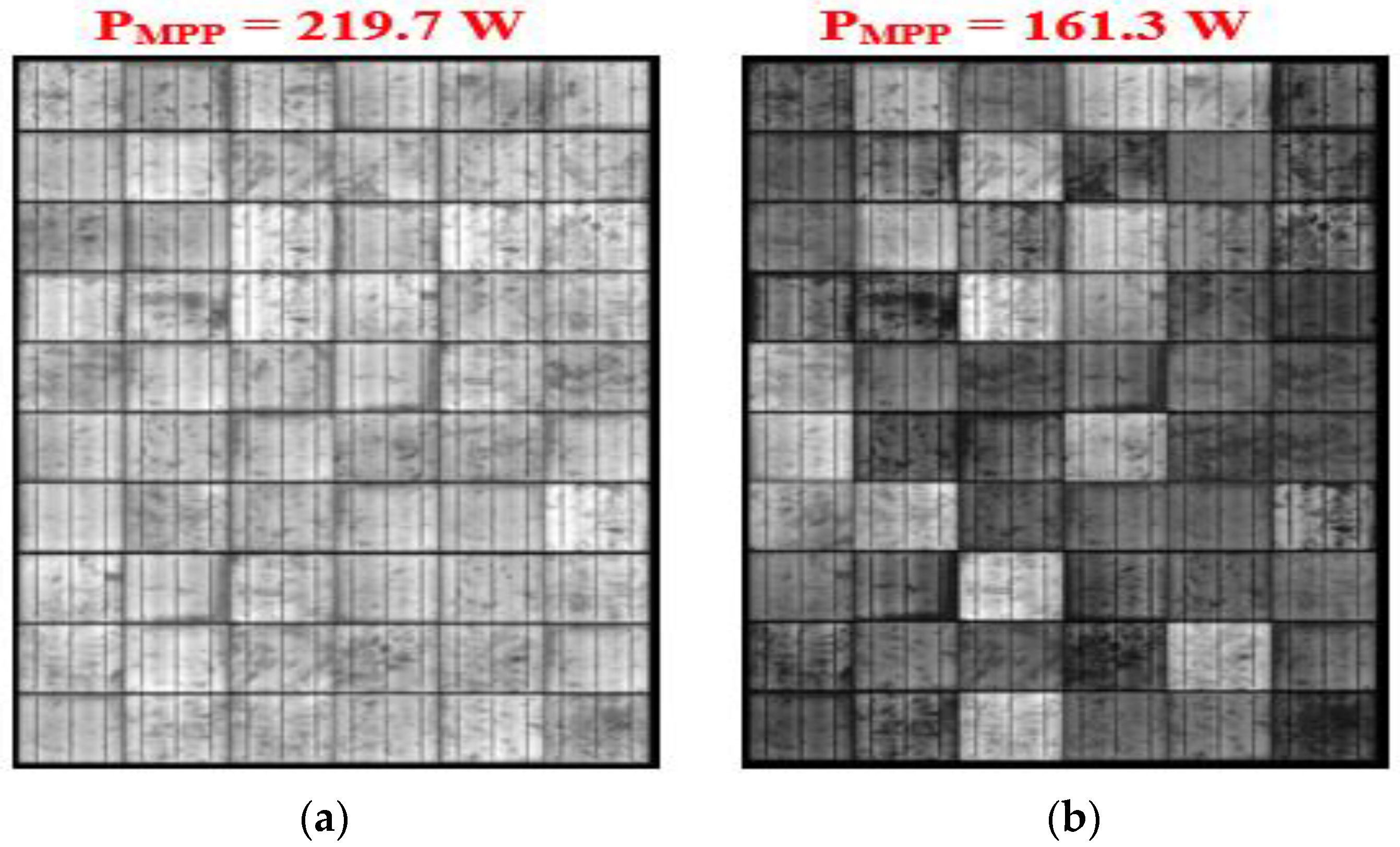
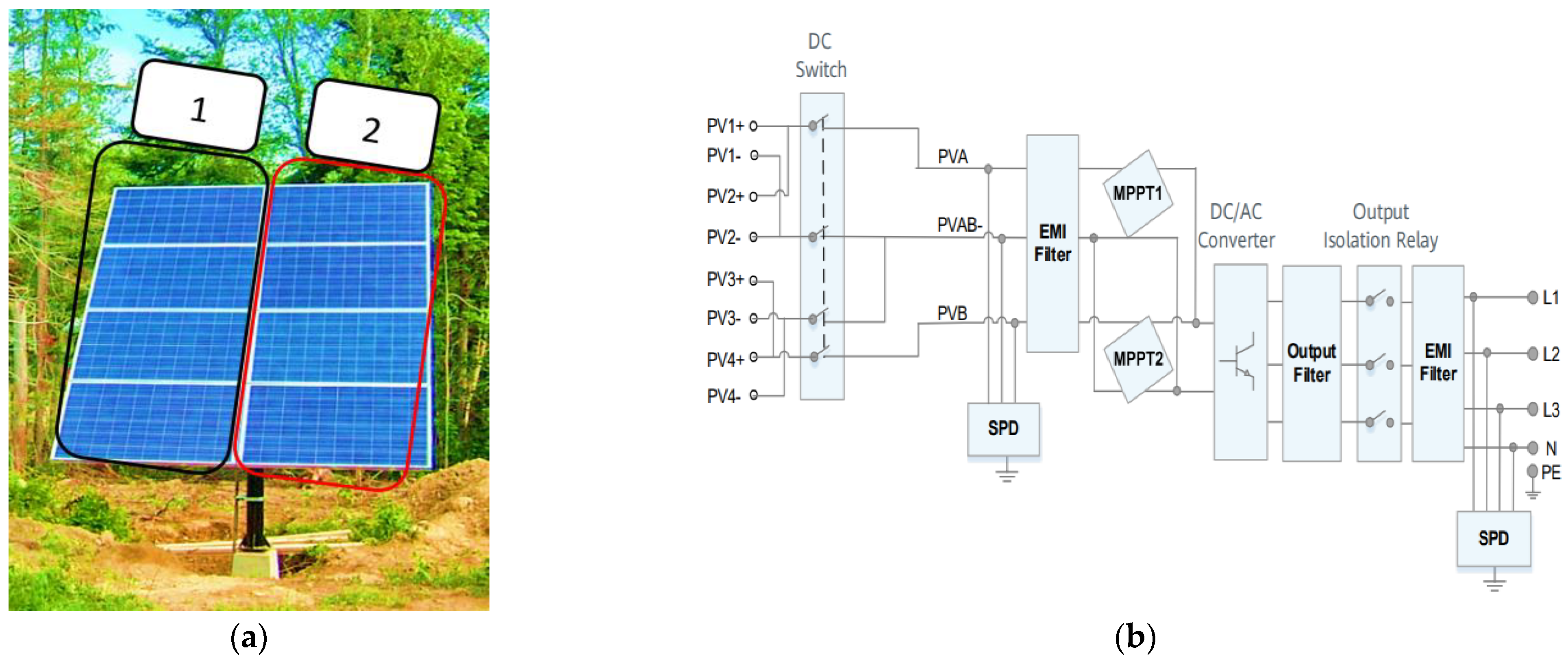
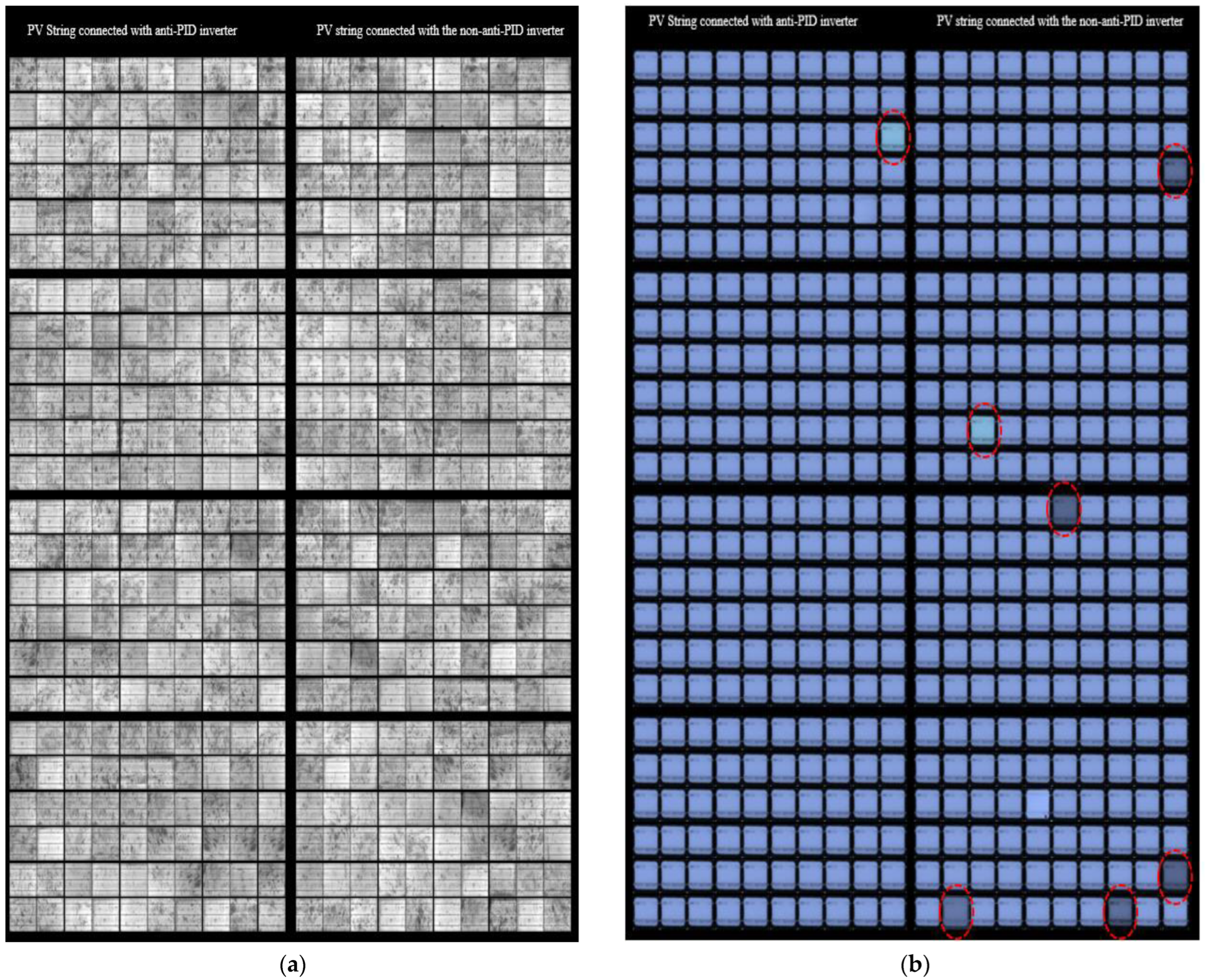
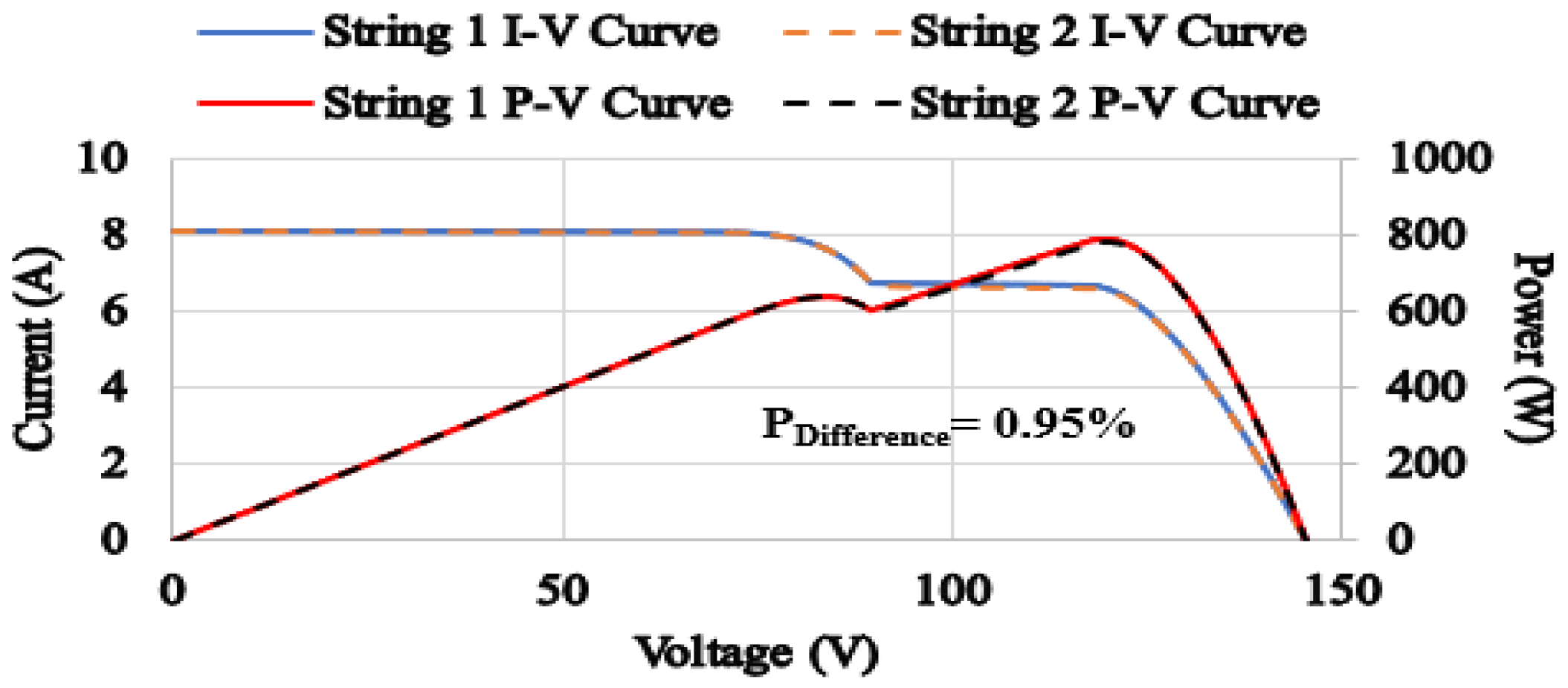

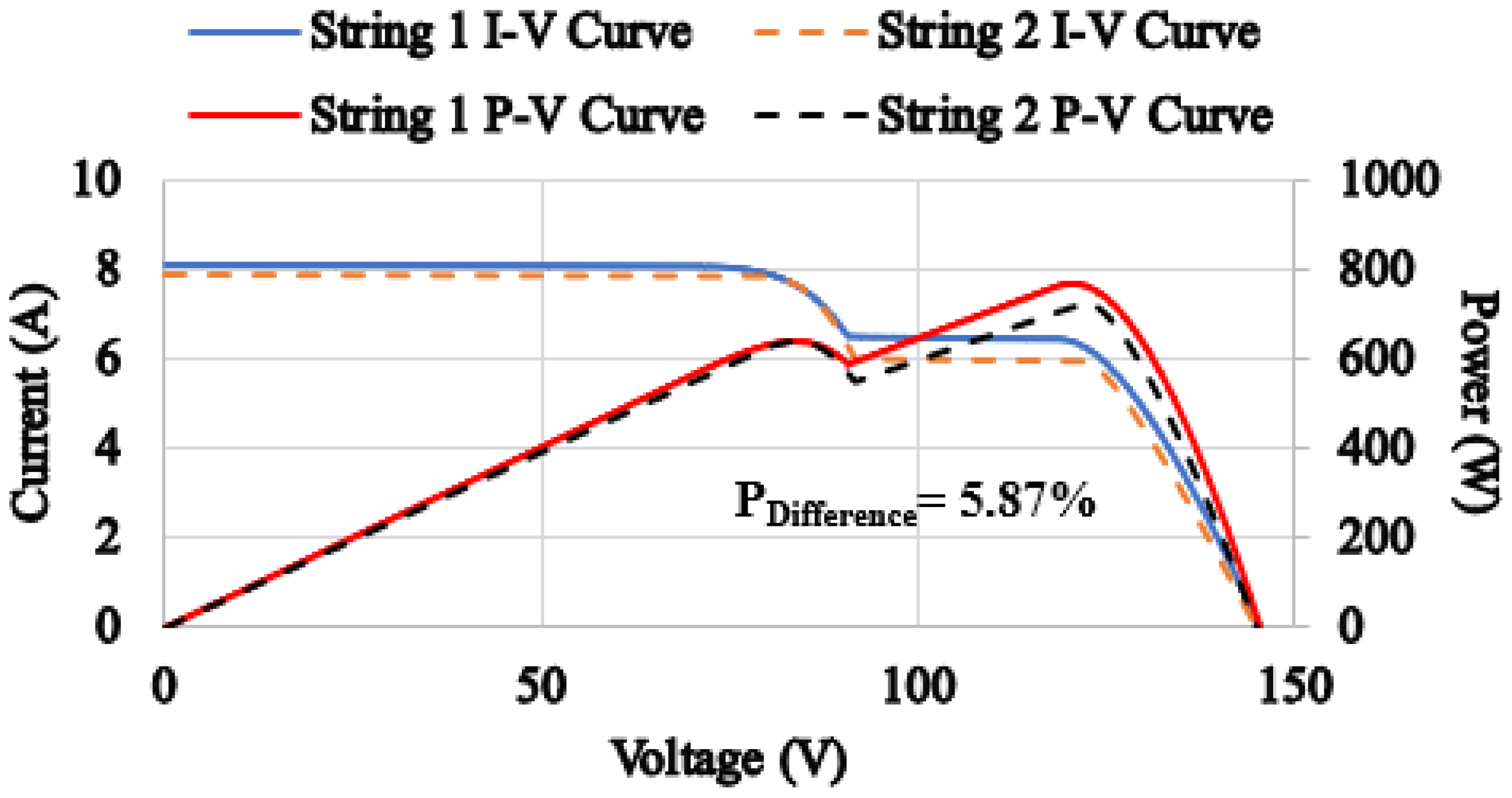
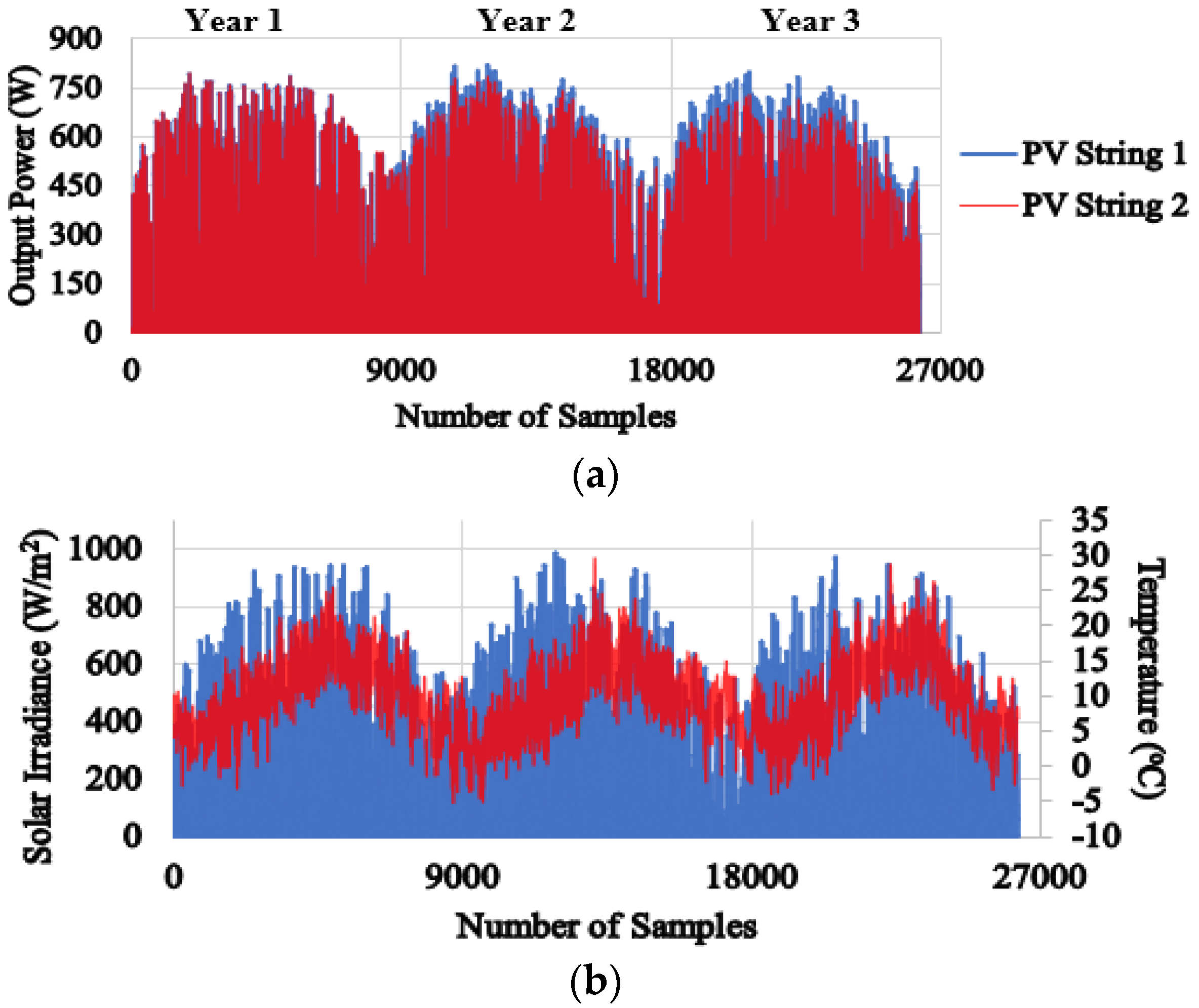
 “) can be excluded since they are unlikely to be true.
“) can be excluded since they are unlikely to be true.
 “) can be excluded since they are unlikely to be true.
“) can be excluded since they are unlikely to be true.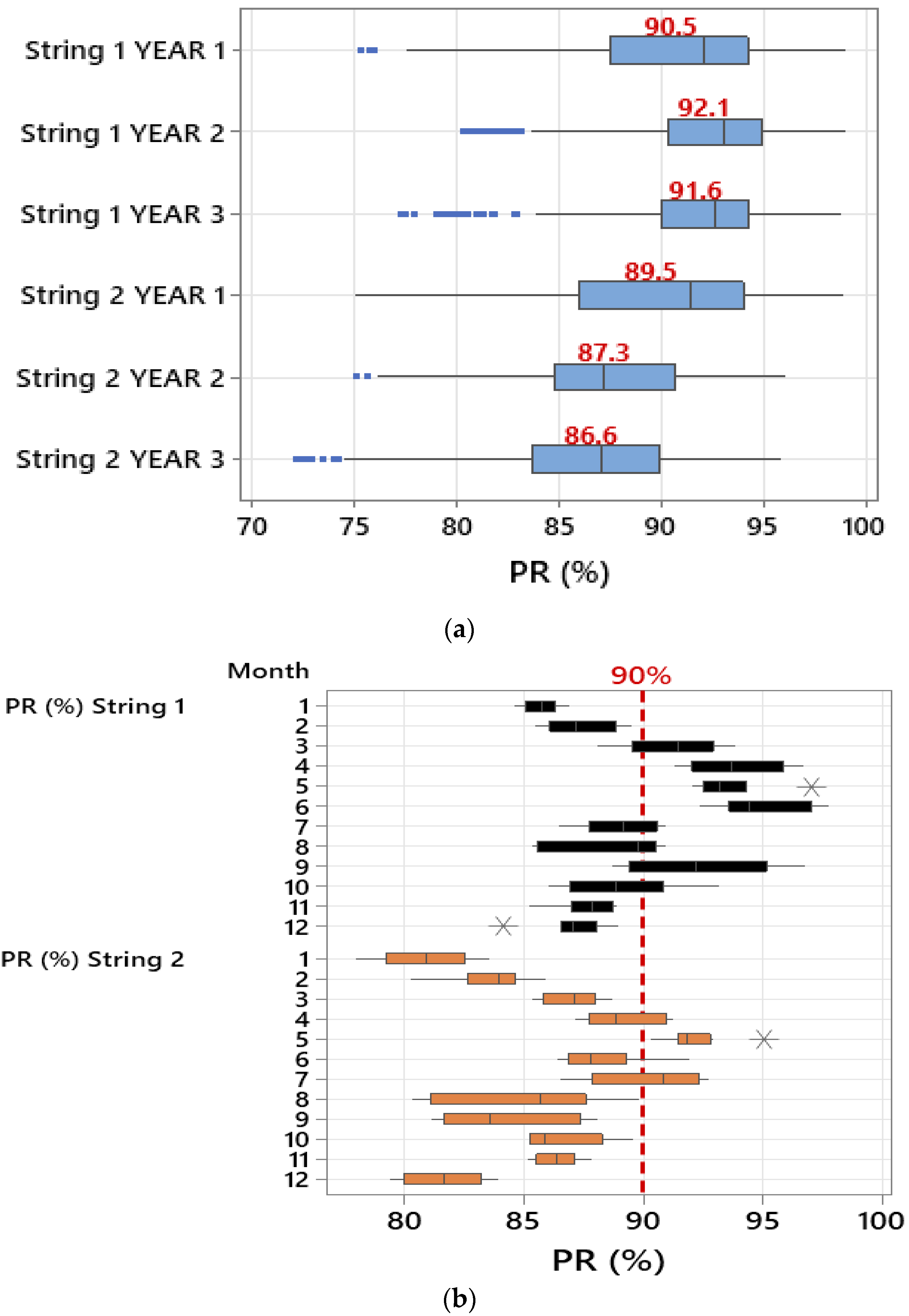


| Parameter | Value |
|---|---|
| Power at maximum power point () | 220 W |
| Current at maximum power point () | 7.68 A |
| Voltage at maximum power point () | 28.65 V |
| Short circuit current () | 8.10 A |
| Open circuit voltage () | 36.6 V |
| Parameter | String 1 | String 2 | Difference (%) |
|---|---|---|---|
| (W) | 770.4 | 727.7 | 5.86 |
| (A) | 8.07 | 7.92 | 1.89 |
| (V) | 145.3 | 144.9 | 0.27 |
| (A) | 6.38 | 5.96 | 7.05 |
| (V) | 120.4 | 122.1 | −1.4 |
| FF (%) | 65.51 | 63.41 | 3.31 |
| PV String | Solar Cell | EL Image | UVF Image | Thermal Image |
|---|---|---|---|---|
| 2 | #1, Day 1 |  |  |  |
| #1, After three years |  |  |  | |
| 2 | #2, Day 1 |  |  |  |
| #2, After three years |  |  |  | |
| 1 | #3, Day 1 |  |  |  |
| #3, After three years |  |  |  |
Disclaimer/Publisher’s Note: The statements, opinions and data contained in all publications are solely those of the individual author(s) and contributor(s) and not of MDPI and/or the editor(s). MDPI and/or the editor(s) disclaim responsibility for any injury to people or property resulting from any ideas, methods, instructions or products referred to in the content. |
© 2023 by the authors. Licensee MDPI, Basel, Switzerland. This article is an open access article distributed under the terms and conditions of the Creative Commons Attribution (CC BY) license (https://creativecommons.org/licenses/by/4.0/).
Share and Cite
Dhimish, M.; Badran, G. Field Study of Photovoltaic Systems with Anti-Potential-Induced-Degradation Mechanism: UVF, EL, and Performance Ratio Investigations. Photonics 2023, 10, 225. https://doi.org/10.3390/photonics10020225
Dhimish M, Badran G. Field Study of Photovoltaic Systems with Anti-Potential-Induced-Degradation Mechanism: UVF, EL, and Performance Ratio Investigations. Photonics. 2023; 10(2):225. https://doi.org/10.3390/photonics10020225
Chicago/Turabian StyleDhimish, Mahmoud, and Ghadeer Badran. 2023. "Field Study of Photovoltaic Systems with Anti-Potential-Induced-Degradation Mechanism: UVF, EL, and Performance Ratio Investigations" Photonics 10, no. 2: 225. https://doi.org/10.3390/photonics10020225
APA StyleDhimish, M., & Badran, G. (2023). Field Study of Photovoltaic Systems with Anti-Potential-Induced-Degradation Mechanism: UVF, EL, and Performance Ratio Investigations. Photonics, 10(2), 225. https://doi.org/10.3390/photonics10020225





